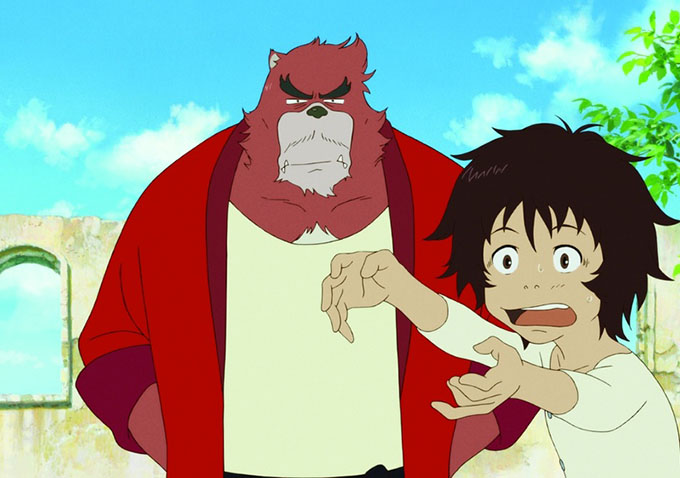
Japanese animation is at an interesting crossroads. At home, it’s obviously as big as ever, and there’s a smattering of hardcore otaku across the world. But the filmmakers who won the most acclaim for those movies, in the West at least, have started to drift away — Oscar-winner Hayao Miyazaki has retired, as has his colleague Isao Takahata, with their Studio Ghibli home winding down, while Satoshi Kon passed away five years ago, and “Akira” helmer Katsuhiro Otomo hasn’t made an animated feature in a decade.
But there is hope, and some of it is in the form of director Mamoru Hosoda, who’s become one of the most hotly-tipped anime filmmakers of the last few years. Though he came from somewhat ignoble beginnings (his first feature was “Digimon: The Movie,” and he was allegedly fired off Ghibli’s “Howl’s Moving Castle”), he’s consistently impressed with his last few features — the acclaimed “The Girl Who Leapt Through Time,” “Summer Wars” and “Wolf Children.” Now, Hosoda’s back with “The Boy And The Beast,” a film that has the potential to be his biggest crossover hit to date.

Over some flashy, semi-abstract CGI, Hosoda sets up his mythology. Adjacent to the world of humans, there’s a word of beasts — humanoid animal creatures. Their lord, the rabbit-ish Soshi (Masahiko Tsugawa) is soon to reincarnate into a god, as the lord is able to do, and a battle will be fought between two potential successors — popular family man Iozen (Kazuhiro Yamaji), and the bear-like, rough-around-the-edges Kumatetsu (megastar Koji Yashuko, of “The Eel” and “Babel”). Kumatetsu has been advised by Soshi to train up an apprentice, and so on a rare foray into the human world, he takes on runaway boy Ren (Aoi Miyazaki, then later in the film Shota Sometani).
READ MORE: The 25 Best Animated Films Of The 21st Century So Far
There’s some resistance from the other beasts, who believe that humans carry inside them a darkness that can turn them into monsters, and Kumatetsu and Ren clash early and often. But over time, they find a sort of mutual respect, and as the beast helps the boy find an inner strength that isn’t simply defined by his physicality, the bear finds himself changing for the best. But Ren is still caught between two worlds, and a darker threat even than that is lurking too.

It’s essentially the halfway point between “The Jungle Book” and “The Karate Kid,” with the focus on a young boy being raised away from his own kind, and on the relationship between him and his furry mentor, who spends two-thirds of the movie training him. Though you get the occasional more frantic moment in the early going, much of the film retains the low-key gentleness of the best of Hosoda’s other work, “Wolf Children” in particular, shines through. It’s a film that takes its time, even as it clearly skews a little younger than his previous pictures, and there’s a sweetly elegiac mood that reminds us of how assured the filmmaker can be.
Not least when it comes to the visuals. There’s again a cunning mix of CGI and hand-drawn animation (for the most part at least: once or twice, as in a deeply naff CGI POV sequence, he misjudges the mix), plenty for fans of character design to get sucked into, and in general, a richly-imagined world. Even the modern-day city sections look kind of spectacular. The eye-candy really kicks up a gear in the final act in particular, when the action gears up in gorgeous fashion.

Unfortunately, that’s when Hosoda’s already-slippery grasp on his story falls away entirely. To begin with, though there are some fun supporting characters (particularly Kamatetsu’s friends, a monkey and a pig-faced monk seemingly inspired by “Journey To The West”), neither Kumatetsu or Ren are particularly well-drawn and compelling, or even likable. We get that we’re meant to be gradually moved by their surrogate father-son relationship, because it’s hitting all the familiar beats, but it never actually happens. The stakes are also particularly low in the early going: we don’t particularly learn why Kumatetsu wants to be the new lord, why he took on an apprentice, or why the guardians Ren ran away from are so awful.
The second act loses focus swiftly, as a now 17-year-old Ren returns to the human world, becomes interested in going to school, reconnects with his real dad in a squandered, undernourished subplot, and falls for a human girl, Kaede (Suzu Hirose), a character who’s never given a trait beyond "supportive girlfriend" — even for a film that’s about fathers and sons, it’s transparently uninterested in women.
 Then the film throws away its subtler, gentler side for an all-action third-act that throws in an unconvincing and highly telegraphed twist involving a minor character, and turns into a sort of superheroic, explosive brawler in a way that feels entirely conventional, and mostly disappointing, not least because it fatally sidelines the central relationship.
Then the film throws away its subtler, gentler side for an all-action third-act that throws in an unconvincing and highly telegraphed twist involving a minor character, and turns into a sort of superheroic, explosive brawler in a way that feels entirely conventional, and mostly disappointing, not least because it fatally sidelines the central relationship.
There are elements of “The Boy And The Beast” that undoubtedly reinforce the promise that Hosoda holds: it’s a treat to look at, is inventive in spots, and will probably be eaten up by younger viewers. But it ultimately proves both narratively unsatisfying and emotionally lacking, and if it proves that Hosoda is an artist, it also suggests he’s got some way to go as a storyteller before he’ll be ranked with Miyazaki and co. [C]
This is a reprint of our review from the 2015 BFI London Film Festival.

